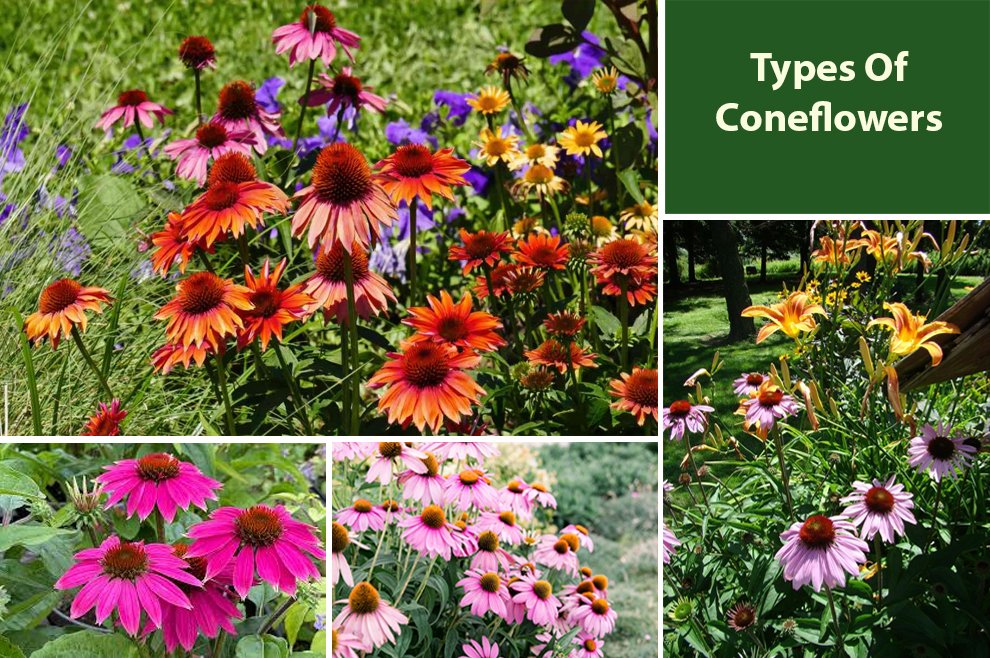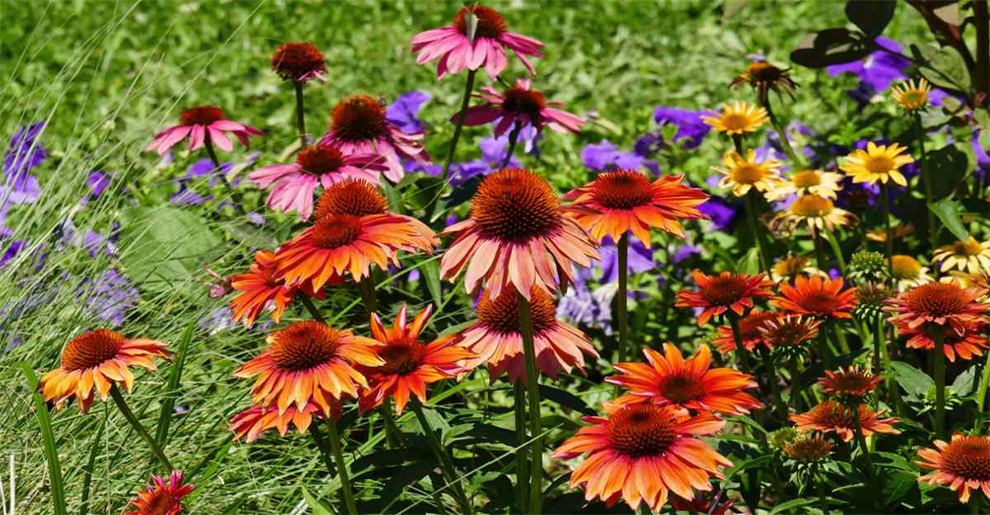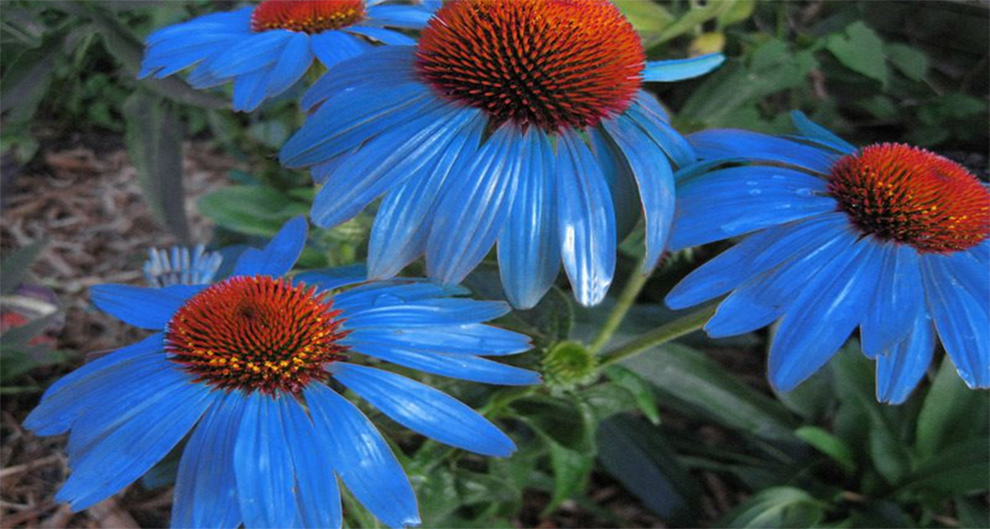Types Of Coneflower (Echinacea) Cultivars & Species
You can classify coneflowers based on their flower color or as rare, native, dwarf, and hybrid coneflowers.

There are several coneflower varieties. Each has its distinct growing requirements and unique characteristics.
Some popular kinds include Purple coneflower, Eastern coneflower, Narrow-leaved coneflower, Smooth coneflower, Tennessee coneflower, and Ozark coneflower.
Hybrids and cultivars of these species are also available. Knowing about different coneflowers and their characteristics can help you select the correct plant for your garden and form an attractive display of texture and color.
Coneflower (Echinacea) Varieties
- Native Coneflower Types
- Dwarf Coneflowers
- Hybrid Coneflowers
- Unusual or Rare Coneflowers
- Coneflowers Based on Color
Native to North America, Coneflowers are a group of popular flowering plants in the genus Echinacea. Below we will discuss the different types of echinacea (coneflowers) briefly one by one.
A. Native coneflower types
These include plants that occur naturally in North America and have evolved to adapt to the local soil conditions and climate. These species are a crucial aspect of the ecosystem, providing habitat and food for wildlife.
Different types of coneflowers are also prized for their ornamental qualities in the garden. Planting native coneflowers can help support biodiversity and promote landscaping practices.
Here are some of the most likable Native coneflowers:
1. Purple Coneflower or (Echinacea purpurea)
| Color | Pinkish-purple with an orange-brown central disk |
| Bloom time | Mid-summer to early fall |
| Height | Can grow up to 4 feet tall |
It is a herbaceous perennial plant widely cultivated and a well-known coneflower species known for its spiky orange-attractive flowers and long-lasting blooms.
Native to Central and Eastern North America, Purple Coneflower is usually grown in gardens for its ornamental value. It is a hardy plant that can thrive in different soil types but prefers full sun to partial shade.
Beyond its ornamental value, Purple Coneflower is also widely used in herbal medicine for its potential immune-boosting and anti-inflammatory properties.
2. Pale purple coneflower (Echinacea pallida)
| Color | Pale pink/lavender |
| Bloom time | Late spring to early summer |
| Height | 3-4 feet tall |
A native plant of the eastern and central United States, the Pale Purple coneflower species is a perennial herb that prefers well-drained soils and full sun.
Characterized by its drooping, long petals, and dark central dish, the Pale Purple Coneflower can grow up to five feet tall, provided it receives favorable growing conditions.
The plant is known for its traditional medicinal uses. It helps treat infections, flu, and colds and is a general immune system booster.
3. Tennessee coneflower (Echinacea tennesseensis)
| Color | Purple-pink |
| Bloom time | Summer |
| Height | 1 to 3 feet |
It is one of the rare and endangered coneflower varieties. It is endemic to the cedar glades and barrens of central Tennessee. It is a herbaceous perennial that cherishes full sun to partial shade and well-drained soil.
The plant is characterized by reflexed, narrow petals and a dark, domed central disk. Conservation efforts have been made to protect this species from habitat destruction and over-harvesting for its ornamental and medicinal value.
This variety is typically employed in ecological restoration projects to help restore and preserve the cedar glade ecosystem.
Some other types of echinacea under this category include:
- Yellow coneflower (Echinacea paradoxa)
- Ozark coneflower (Echinacea simulata)
- Smooth coneflower (Echinacea laevigata)
- Narrow-leaved coneflower (Echinacea angustifolia)
- Prairie coneflower (Ratibida columnifera)
B. Dwarf coneflower varieties
These refer to a group of coneflowers that are smaller in size than their wild counterparts. These varieties are bred, particularly for their uniform shape and compact size, making them suitable for borders, containers, and small gardens.
One unique attribute of dwarf coneflowers is their ability to yield an abundance of beautiful flowers, despite their small stature.
You can find them in different colors, including shades of yellow, orange, pink, and purple. These have a long blooming period, from late spring through early fall. Their compact size makes them wind-resistant.
Below we enlist the most likable Dwarf echinacea varieties:. They can also endure environmental stresses better than taller coneflowers.
1. Kim’s Knee High coneflower (Echinacea purpurea Kim’s Knee High)
| Color | Pinkish-purple |
| Bloom time | Midsummer to early fall |
| Height | 18-24 inches tall |
Kim’s Knee High Coneflower is a dwarf cultivar of the purple coneflower. It is known for its attractive flowers and compact size.
These types of coneflowers produce showy and bright blooms with prominent dark cones that attract pollinators, including butterflies and bees.
You can opt for this specie if you intend to grow in containers or small gardens. They are also great as edging plants in borders.
2. Pixie Meadowbrite coneflower (Echinacea purpurea Pixie Meadowbrite)

| Color | Bright, magenta-pink with prominent, dark cones |
| Bloom time | Midsummer to early fall |
| Height | 12-18 inches |
It is another charming compact cultivar of the purple coneflower. Pixie Meadowbrite coneflowers are known for their compact habit and striking flowers. This variety produces bright, daisy-like blooms.
These types of coneflowers attract pollinators, including bees and butterflies. They are popular among gardeners who want to add a pop of color to their landscape without taking up too much space.
3. Little Magnus coneflower (Echinacea purpurea Little Magnus)
| Color | Pink-purple |
| Bloom time | Midsummer to fall |
| Height | 12-18 inches |
It is a delightful dwarf cultivar that stands out for its unique petals. The plant has slightly drooping petals surrounding a large central cone, giving the flower a distinct appearance.
The cultivar is known for its compact size, making it ideal for containers, rock gardens, and small gardens.
Little Magnus Coneflower blooms attract bees, butterflies, and other pollinators to the gardens. These coneflowers are easy to grow, tolerate a wide range of soil conditions, and are drought-tolerant once established.
Hence, it is an excellent pick for gardeners who wish for a low-maintenance perennial that adds color and interest to their garden.
Some other echinacea varieties under this category include:
- Little Magnus coneflower (Echinacea purpurea Little Magnus)
- Meringue coneflower (Echinacea Meringue)
- Pink Double Delight coneflower (Echinacea Pink Double Delight)
- Kims Mophead coneflower (Echinacea Kims Mophead)
- Green Jewel coneflower (Echinacea Green Jewel)
C. Hybrid coneflower cultivars
These coneflowers are created by crossbreeding two or more Coneflower types to produce a new variety with desirable traits. These cultivars can offer an array of colors, sizes, and shapes, as well as improved disease resistance, larger flowers, and longer blooming periods.
Hybrid Coneflowers can also be more adaptable to different growing conditions and climates, making them a spectacular choice for gardeners seeking low-maintenance perennials that can thrive in different environments.
Because of their unique benefits and characteristics, hybrid coneflowers are becoming excessively popular amongst gardeners in recent years.
1. Magnus coneflower (Echinacea purpurea Magnus)
| Color | Deep pink |
| Bloom time | Summer to fall |
| Height | 2-4 feet |
These coneflower varieties are known for their deep, large pink petals surrounding the cone-shaped, dark center. The flowers stand tall on the sturdy stems, making them an excellent pick for cut flower arrangements.
Magnus Coneflowers also have a long blooming period, lasting well into the fall. Another unique feature of Magnus Coneflowers is their drought tolerance, which makes them a low-maintenance addition to any garden.
2. PowWow Wild Berry coneflower (Echinacea purpurea PowWow Wild Berry)
| Color | Deep rose-pink |
| Bloom time | Summer to fall |
| Height | 2-3 feet |
These echinacea varieties are prized for their magenta flowers that bloom in a bushy, compact form. Their petals are somewhat more rounded than other Coneflowers, and the dark cone-shaped center offers a striking contrast.
PowWow Wild Berry Coneflowers are known for their robust growth and ability to attract pollinators. These cultivars are also highly resistant to disease and pests, making them a great addition to any garden.
3. Doubledecker coneflower (Echinacea purpurea Doubledecker)
| Color | Pink and white |
| Bloom time | Summer to fall |
| Height | 2-3 feet |
As is clear from the name, this coneflower species is unique courtesy of its two sets of petals that give the flowers a layered look.
The other petals are lavender or pink colored, whereas the inner petals are deep burgundy. The dark center cone adds a striking accent.
Doubledecker Coneflowers are known for their long blooming period and ability to attract birds and butterflies. It is also an excellent selection for flower cut arrangements, and its long stems make it easy to work with.
Some other echinacea varieties under this category include:
- Sunrise Echinacea (Echinacea x Sunrise)
- Hot Papaya Coneflower (Echinacea x Hot Papaya)
- Sombrero Salsa Red Coneflower (Echinacea x Balsomsed PPAF)
- Cheyenne Spirit Coneflower (Echinacea x Cheyenne Spirit PPAF)
- Tomato Soup Coneflower (Echinacea x Tomato Soup)
D. Unusual or Rare Coneflowers
These coneflower cultivars are not commonly seen in garden centers or nurseries. The Rare Coneflowers are challenging to grow and have unique features that make them stand out from other species.
Such varieties add intrigue and interest to a garden. Some of the unusual or rare coneflowers include:
- Green Twister Coneflower (Echinacea Green Twister)
- Ruby Star Coneflower (Echinacea purpurea Ruby Star)
- Ozark Coneflower (Echinacea paradoxa var. neglecta)
- Solar Flare Coneflower (Echinacea Solar Flare)
- Flame Thrower Coneflower (Echinacea Flame Thrower)
Related: Different types of flowers |Coneflower winter care
Types Of Echinacea Based On Color
As stated above, you can find coneflowers in different colors. So, below we will see this divide and look at some popular blooms under each color category.
Orange Coneflowers
These are a good pick for gardeners hoping to add a pop of warm color to their landscape. Such coneflower varieties come in different orange tones, from light peach to deep, burnt orange.
The orange coneflowers attract bees and pollinators and are known for their drought tolerance Examples of the orange cornflowers include:
- Echinacea Tangerine Dream
- Echinacea Sunrise
- Echinacea Harvest Moon
- Echinacea Flame Thrower
- Echinacea Orange Meadowbrite
Blue Coneflowers

These coneflower cultivars are an eye-catching and unique addition to the garden. You can find them in different colors, from pale blue to deep violet-blue, and often have a striking contrast with their dark cone-shaped centers.
They are the perfect selection for gardeners seeking to add a cool tone to their yards. Some examples of blue coneflowers include:
- Echinacea Blue Paradise
- Echinacea Blue Steel
- Echinacea Blue Jay
- Echinacea Blue Horizon
- Echinacea Blue Angel
Red Coneflowers
They are a beautiful and bold choice for any garden. These range from deep maroon to bright red and usually have a contrasting center cone.
Many red coneflower varieties are said to have medicinal properties and have been used traditionally by Native American tribes to treat a variety of ailments.
Planting these species in a mixed border or as a focal point adds a sharp pop of vibrant color and attracts beneficial wildlife.
Some examples of red coneflowers include:
- Echinacea Red Knee
- Echinacea Ruby Star
- Echinacea Tomato Soup
- Echinacea Firebird
- Echinacea Scarlet Ohara
Purple Coneflowers
These are a classic choice for every garden. You can find Purple coneflowers in shades of light lavender to deep purple. They typically have contrasting center cones and are known for their ornamental and medicinal uses.
They are also a spectacular choice for gardeners hoping to attract pollinators, including butterflies and bees. Purple coneflowers are a versatile and hardy plant that will make a lovely addition to any garden.
Some examples of purple coneflower varieties include:
- Echinacea purpurea
- Echinacea Magnus
- Echinacea Vintage Wine
- Echinacea Purple Emperor
- Echinacea Purple Coneflower
Pink Coneflower
These are a romantic and delicate choice for any garden. Pink coneflowers range from light pink to deep magenta and often have contrasting center cones.
Such flowers are attractive to butterflies, hummingbirds, and bees. They are a great addition to cottage-style gardens, mixed borders, or rock gardens.
Pink Coneflowers have graceful, daisy-like flowers and long bloom times. They make a beautiful addition to any garden or landscape.
Some examples of pink coneflowers include:
- Echinacea Pink Double Delight
- Echinacea Pink Shimmer
- Echinacea Pink Poodle
- Echinacea Pink Parasol
- Echinacea Pink Sky
White Coneflowers
These are classic and clean echinacea varieties for any garden. They range from pure white to creamy ivory and often have contrasting center cones.
White coneflowers are known for their ability to attract pollinators and their long blooming period. Some examples of white coneflowers include:
- Echinacea White Swan
- Echinacea Fragrant Angel
- Echinacea PowWow White
- Echinacea Virgin
What coneflower blooms all summer?
Echinacea Summer Sky, Purple Coneflower, Echinacea purpurea Hot Papaya, and Echinacea purpurea Magnus are some varieties that bloom all summer.
You might like to read about other perennials that bloom all summer.
Are all coneflower varieties edible?
Even though echinacea has long been used for medicinal purposes, they are not all edible. Some species contain harmful compounds like alkaloids that may cause adverse effects if ingested in large quantities.
Further, some cultivars may have been treated with chemicals or pesticides, making them unsafe for consumption.
